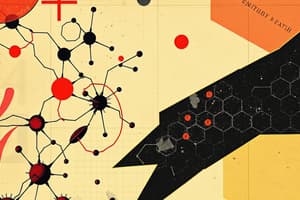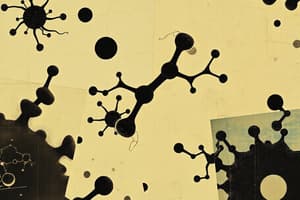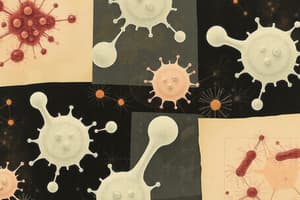Podcast
Questions and Answers
Where are carbohydrates usually attached to in most immunoglobulins?
Where are carbohydrates usually attached to in most immunoglobulins?
- NH2 domain
- COOH domain
- CH2 domain (correct)
- CO domain
What is the basis of classification of human immunoglobulins into five classes?
What is the basis of classification of human immunoglobulins into five classes?
- Carbohydrate content
- Antigenic determinants
- Light chains
- Heavy chains (correct)
Which immunoglobulin exists as a monomer, dimer, or pentamer?
Which immunoglobulin exists as a monomer, dimer, or pentamer?
- IgA (correct)
- IgG
- IgM
- IgE
What is the primary function of IgE?
What is the primary function of IgE?
Which immunoglobulin is responsible for transplacental passage?
Which immunoglobulin is responsible for transplacental passage?
What is the function of IgD?
What is the function of IgD?
Which immunoglobulin has the highest serum concentration?
Which immunoglobulin has the highest serum concentration?
What is the primary function of IgA?
What is the primary function of IgA?
Which type of cells produce immunoglobulins?
Which type of cells produce immunoglobulins?
What type of bonds link the heavy and light chains together in immunoglobulins?
What type of bonds link the heavy and light chains together in immunoglobulins?
In immunoglobulins, what does the 'VL' region stand for?
In immunoglobulins, what does the 'VL' region stand for?
The hinge region of an antibody provides which characteristic?
The hinge region of an antibody provides which characteristic?
What is the molar mass range of the heavy chains in immunoglobulins?
What is the molar mass range of the heavy chains in immunoglobulins?
Which of the following regions are found in a light chain of immunoglobulins?
Which of the following regions are found in a light chain of immunoglobulins?
What are the functions of immunoglobulins?
What are the functions of immunoglobulins?
Which regions based on amino acid sequences variability are found in the heavy chain of immunoglobulins?
Which regions based on amino acid sequences variability are found in the heavy chain of immunoglobulins?
Flashcards are hidden until you start studying
Study Notes
Immunoglobulins
- Immunoglobulins are glycoprotein molecules produced by plasma cells, a critical component of the immune response.
- They recognize, bind, and destroy specific antigens such as bacteria or viruses.
- Immunoglobulins function as antibodies.
Structure of Immunoglobulins
- Each immunoglobulin has a 4-chain structure consisting of 2 identical heavy chains (53-75 kDa) and 2 identical light chains (23 kDa).
- Heavy and light chains are linked together by disulfide bonds.
- Disulfide bonds include inter-chain disulfide bonds (between polypeptide chains) and intra-chain disulfide bonds (within polypeptide chains).
Regions of Immunoglobulins
- Variable (V) regions: VL (Variable Light) and VH (Variable Heavy) with variable amino acid sequences.
- Constant (C) regions: CL (Constant Light) and CH (Constant Heavy) with constant amino acid sequences.
Domains of Immunoglobulins
- Light Chain Domains: VL and CL.
- Heavy Chain Domains: VH, CH1 to CH3 (or CH4).
Hinge Region
- The hinge region is where the arms of the antibody molecule form a Y, allowing for flexibility in the molecule.
Types of Immunoglobulins
- IgA, IgD, IgE, IgG, and IgM.
- IgG: monomer, 75% serum, 1000 serum concentration.
- IgA: monomer or dimer, 15% serum, 200 serum concentration.
- IgM: pentamer, 9% serum, 120 serum concentration.
- IgD: monomer, 0.2% serum, 3 serum concentration.
- IgE: monomer, 0.04% serum, 0.05 serum concentration.
Functions of Immunoglobulins
- Ag binding: binds to specific antigenic determinants, protecting the host.
- Effector functions: fixation of complement, opsonization of bacteria, and binding to various cells.
Major Functions of Immunoglobulins
- Complement fixation: IgG, IgM.
- Transplacental passage: IgG.
- Mediation of allergic response: IgE.
- Protection of mucosal tissues: IgA.
- Opsonization: IgG.
- B-cell activation: IgD.
- Ag receptor on B-cell: IgM.
Studying That Suits You
Use AI to generate personalized quizzes and flashcards to suit your learning preferences.



